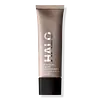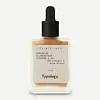Smashbox Halo Healthy Glow Tinted Moisturizer Broad Spectrum SPF 25 Versus Typology Tinted Serum Vitamin C, Squalane & Aloe Vera
What's inside
What's inside
 Key Ingredients
Key Ingredients

 Benefits
Benefits

 Concerns
Concerns

 Ingredients Side-by-side
Ingredients Side-by-side

Ethylhexyl Methoxycinnamate 6.7%
UV AbsorberTitanium Dioxide 3.1%
Cosmetic ColorantZinc Oxide 1.3%
Cosmetic ColorantWater
Skin ConditioningOctyldodecyl Neopentanoate
EmollientButyloctyl Salicylate
Skin ConditioningDimethicone
EmollientButylene Glycol
HumectantMethyl Trimethicone
Skin ConditioningNiacinamide
SmoothingCetyl PEG/PPG-10/1 Dimethicone
EmulsifyingLauryl PEG-9 Polydimethylsiloxyethyl Dimethicone
Skin ConditioningDiethylhexyl Succinate
EmollientLaureth-4
EmulsifyingTocopheryl Acetate
AntioxidantSodium Hyaluronate
HumectantLecithin
EmollientRosa Hybrid Flower Extract
Skin ConditioningPyrus Malus Fruit Extract
Skin ConditioningLens Esculenta Fruit Extract
Skin ConditioningCitrullus Lanatus Fruit Extract
Skin ConditioningLycium Chinense Fruit Extract
AntioxidantPalmitoyl Hexapeptide-14
Skin ConditioningPeat Extract
Skin ConditioningGold
Cosmetic ColorantSodium Lactate
BufferingMethicone
EmollientSodium PCA
HumectantHydrolyzed Wheat Protein/Pvp Crosspolymer
Glycerin
HumectantCI 77120
Cosmetic ColorantMagnesium Sulfate
Dimethyl Isosorbide
SolventMaltodextrin
AbsorbentTriethoxycaprylylsilane
Dimethicone Crosspolymer-3
Skin ConditioningSilica
AbrasiveAluminum Hydroxide
EmollientDimethicone/PEG-10/15 Crosspolymer
Trimethylsiloxysilicate
EmollientHexylene Glycol
EmulsifyingIsostearic Acid
CleansingCaprylyl Glycol
EmollientStearic Acid
CleansingPolyglyceryl-2 Triisostearate
EmulsifyingDipentaerythrityl Tri-Polyhydroxystearate
EmollientDipropylene Glycol
HumectantSodium Citrate
BufferingBHT
AntioxidantDisodium EDTA
Sodium Benzoate
MaskingPotassium Sorbate
PreservativePhenoxyethanol
PreservativeMica
Cosmetic ColorantCI 77891
Cosmetic ColorantCI 77491
Cosmetic ColorantCI 77492
Cosmetic ColorantCI 77499
Cosmetic ColorantCI 77163
Cosmetic ColorantEthylhexyl Methoxycinnamate 6.7%, Titanium Dioxide 3.1%, Zinc Oxide 1.3%, Water, Octyldodecyl Neopentanoate, Butyloctyl Salicylate, Dimethicone, Butylene Glycol, Methyl Trimethicone, Niacinamide, Cetyl PEG/PPG-10/1 Dimethicone, Lauryl PEG-9 Polydimethylsiloxyethyl Dimethicone, Diethylhexyl Succinate, Laureth-4, Tocopheryl Acetate, Sodium Hyaluronate, Lecithin, Rosa Hybrid Flower Extract, Pyrus Malus Fruit Extract, Lens Esculenta Fruit Extract, Citrullus Lanatus Fruit Extract, Lycium Chinense Fruit Extract, Palmitoyl Hexapeptide-14, Peat Extract, Gold, Sodium Lactate, Methicone, Sodium PCA, Hydrolyzed Wheat Protein/Pvp Crosspolymer, Glycerin, CI 77120, Magnesium Sulfate, Dimethyl Isosorbide, Maltodextrin, Triethoxycaprylylsilane, Dimethicone Crosspolymer-3, Silica, Aluminum Hydroxide, Dimethicone/PEG-10/15 Crosspolymer, Trimethylsiloxysilicate, Hexylene Glycol, Isostearic Acid, Caprylyl Glycol, Stearic Acid, Polyglyceryl-2 Triisostearate, Dipentaerythrityl Tri-Polyhydroxystearate, Dipropylene Glycol, Sodium Citrate, BHT, Disodium EDTA, Sodium Benzoate, Potassium Sorbate, Phenoxyethanol, Mica, CI 77891, CI 77491, CI 77492, CI 77499, CI 77163
Water
Skin ConditioningIsoamyl Laurate
EmollientC9-12 Alkane
SolventSqualane
EmollientPolyglyceryl-3 Diisostearate
EmulsifyingPropanediol
SolventSilica
AbrasivePolyglyceryl-6 Polyricinoleate
EmulsifyingGlycerin
HumectantMagnesium Sulfate
Ascorbyl Tetraisopalmitate
AntioxidantPolyglyceryl-2 Isostearate
EmulsifyingCoco-Caprylate/Caprate
EmollientDisteardimonium Hectorite
StabilisingHydroxyethylcellulose
Emulsion StabilisingSodium Benzoate
MaskingDisodium Stearoyl Glutamate
CleansingPotassium Sorbate
PreservativeAloe Barbadensis Leaf Juice
Skin ConditioningAluminum Hydroxide
EmollientSodium Nitrate
SoothingCI 77891
Cosmetic ColorantCI 77492
Cosmetic ColorantCI 77491
Cosmetic ColorantCI 77499
Cosmetic ColorantWater, Isoamyl Laurate, C9-12 Alkane, Squalane, Polyglyceryl-3 Diisostearate, Propanediol, Silica, Polyglyceryl-6 Polyricinoleate, Glycerin, Magnesium Sulfate, Ascorbyl Tetraisopalmitate, Polyglyceryl-2 Isostearate, Coco-Caprylate/Caprate, Disteardimonium Hectorite, Hydroxyethylcellulose, Sodium Benzoate, Disodium Stearoyl Glutamate, Potassium Sorbate, Aloe Barbadensis Leaf Juice, Aluminum Hydroxide, Sodium Nitrate, CI 77891, CI 77492, CI 77491, CI 77499
 Reviews
Reviews

Ingredients Explained
These ingredients are found in both products.
Ingredients higher up in an ingredient list are typically present in a larger amount.
Aluminum Hydroxide is a form of aluminum. It can be naturally found in nature as the mineral gibbsite. In cosmetics, Aluminum Hydroxide is used as a colorant, pH adjuster, and absorbent.
As a colorant, Aluminum Hydroxide may add opacity, or reduce the transparency. Aluminum hydroxide is contains both basic and acidic properties.
According to manufacturers, this ingredient is an emollient and humectant. This means it helps hydrate the skin.
In medicine, this ingredient is used to help relieve heartburn and help heal ulcers.
There is currently no credible scientific evidence linking aluminum hydroxide in cosmetics to increased cancer risk.
Major health organizations allow the use of aluminum hydroxide in personal care products and have not flagged it as a carcinogenic risk at typical usage levels.
Learn more about Aluminum HydroxideCi 77491 is also hydrated iron III oxide. It's sole purpose is to give a red/pink hue to products.
Iron III oxides are classified as inorganic chemicals for coloring.
Synthetically created Ci 77491 is considered safer than those naturally found. This is because the synthetically created version may contain less impurities. Iron oxides are generally non-toxic and non-allergenic.
Learn more about CI 77491Ci 77492 is also hydrated iron III oxide. It's sole purpose is to give a yellow hue to products.
Iron III oxides are classified as inorganic chemicals for coloring.
Synthetically created Ci 77492 is considered safer than those naturally found. This is because the synthetically created version may contain less impurities. Iron oxides are generally non-toxic and non-allergenic.
Learn more about CI 77492Ci 77499 is also hydrated iron III oxide. It is created from mixing red and black iron oxides. This helps give shades of darkness to a product.
Iron III oxides are classified as inorganic chemicals for coloring.
Ci 77891 is a white pigment from Titanium dioxide. It is naturally found in minerals such as rutile and ilmenite.
It's main function is to add a white color to cosmetics. It can also be mixed with other colors to create different shades.
Ci 77891 is commonly found in sunscreens due to its ability to block UV rays.
Learn more about CI 77891Glycerin is already naturally found in your skin. It helps moisturize and protect your skin.
A study from 2016 found glycerin to be more effective as a humectant than AHAs and hyaluronic acid.
As a humectant, it helps the skin stay hydrated by pulling moisture to your skin. The low molecular weight of glycerin allows it to pull moisture into the deeper layers of your skin.
Hydrated skin improves your skin barrier; Your skin barrier helps protect against irritants and bacteria.
Glycerin has also been found to have antimicrobial and antiviral properties. Due to these properties, glycerin is often used in wound and burn treatments.
In cosmetics, glycerin is usually derived from plants such as soybean or palm. However, it can also be sourced from animals, such as tallow or animal fat.
This ingredient is organic, colorless, odorless, and non-toxic.
Glycerin is the name for this ingredient in American English. British English uses Glycerol/Glycerine.
Learn more about GlycerinMagnesium Sulfate is a salt. More specifically, it is an epsom salt, or the bath salt used to help relieve muscle aches.
Despite having ‘sulfate’ in the name, it isn’t a surfactant or cleansing agent like sodium lauryl sulfate. Unlike those sulfates, magnesium sulfate doesn’t have the same cleansing or foaming properties (it's simply a type of salt).
In cosmetics, Magnesium Sulfate is used to thicken a product or help dilute other solids. It is a non-reactive and non-irritating ingredient.
One study shows magnesium deficiency may lead to inflammation of the skin. Applying magnesium topically may help reduce inflammation.
You can find this ingredient in sea water or mineral deposits.
Learn more about Magnesium SulfatePotassium Sorbate is a preservative used to prevent yeast and mold in products. It is commonly found in both cosmetic and food products.
This ingredient comes from potassium salt derived from sorbic acid. Sorbic acid is a natural antibiotic and effective against fungus.
Both potassium sorbate and sorbic acid can be found in baked goods, cheeses, dried meats, dried fruit, ice cream, pickles, wine, yogurt, and more.
You'll often find this ingredient used with other preservatives.
Learn more about Potassium SorbateSilica, also known as silicon dioxide, is a naturally occurring mineral. It is used as a fine, spherical, and porous powder in cosmetics.
Though it has exfoliant properties, the function of silica varies depending on the product.
The unique structure of silica enhances the spreadability and adds smoothness, making it a great texture enhancer.
It is also used as an active carrier, emulsifier, and mattifier due to its ability to absorb excess oil.
In some products, tiny microneedles called spicules are made from silica or hydrolyzed sponge. When you rub them in, they lightly polish away dead skin layers and enhance the penetration of active ingredients.
Learn more about SilicaSodium Benzoate is a preservative. It's used in both cosmetic and food products to inhibit the growth of mold and bacteria. It is typically produced synthetically.
Both the US FDA and EU Health Committee have approved the use of sodium benzoate. In the US, levels of 0.1% (of the total product) are allowed.
Sodium benzoate works as a preservative by inhibiting the growth of bacteria inside of cells. It prevents the cell from fermenting a type of sugar using an enzyme called phosphofructokinase.
It is the salt of benzoic acid. Foods containing sodium benzoate include soda, salad dressings, condiments, fruit juices, wines, and snack foods.
Studies for using ascorbic acid and sodium benzoate in cosmetics are lacking, especially in skincare routines with multiple steps.
We always recommend speaking with a professional, such as a dermatologist, if you have any concerns.
Learn more about Sodium BenzoateWater. It's the most common cosmetic ingredient of all. You'll usually see it at the top of ingredient lists, meaning that it makes up the largest part of the product.
So why is it so popular? Water most often acts as a solvent - this means that it helps dissolve other ingredients into the formulation.
You'll also recognize water as that liquid we all need to stay alive. If you see this, drink a glass of water. Stay hydrated!
Learn more about Water